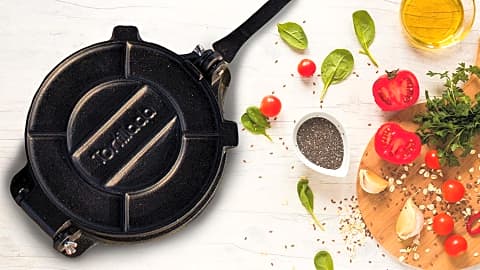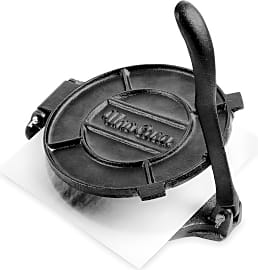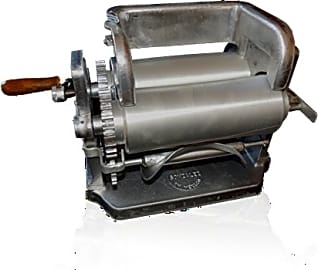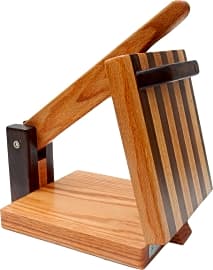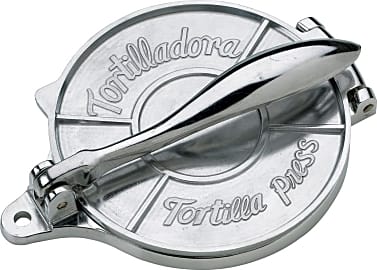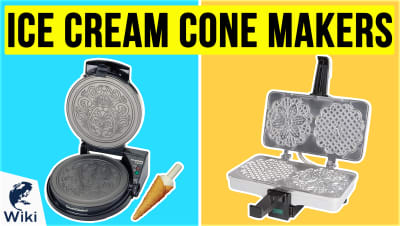The 7 Best Tortilla Makers

This wiki has been updated 41 times since it was first published in April of 2015. Once you grow accustomed to taco and tostada shells made from scratch, you won’t want them any other way. Luckily, you can whip up a tasty batch with the tortilla presses we’ve listed here. Just run your dough through these and you'll have round, flat wraps, ready to be fried and filled with your favorite ingredients. Most of these work for roti, empanadas, and other foods, too. When users buy our independently chosen editorial selections, we may earn commissions to help fund the Wiki.
Editor's Notes
May 07, 2021:
Here's a category where newer and more advanced does not equal better. In fact, we dug deep to find a single self-heating electric tortilla maker that's dependable, safe, and durable for long-term use, and we aren't confident that such a thing exists. Some electric models with plastic handles and brushed-metal exteriors look great and work well at first, but they tend to heat inconsistently and break down easily across the board.
To that end, we've removed our electric recommendation as well as an aluminum version we previously suggested, because its finish chipped off for too many users. We recommend getting a traditional model like the Victoria Pataconera TOR or Tortillada TP-003. If you want something simple that also has a distinguished look, consider the Central Coast Woodworks 8-Inch Press. Large outfits might appreciate the Gonzalez Maquina Tortilladora, which can pump out quite a few shells but does have a bit of a learning curve.
January 17, 2020:
If you are a tortilla snob, we know you are very particular about just how well your press handles your specially-made mounds of dough, so we looked for high-quality materials and builds to ensure you get those perfectly round and flat wraps you are looking for. The plates of the Tortillada TP-003 shut tightly together, helping you create thin and even tortillas. However, we removed the CucinaPro Electric as it struggled to close on thick dough. We like that the Victoria Pataconera TOR features cast iron construction, and should stand up to plenty of use. On the other hand, the Brilliant Cook Press didn't pass the longevity test, as the handle was too fragile, so it lost its spot on the list.
Everyone has different tastes when it comes to what they make with their tortillas, so we included a few different sizes for various recipes. The Tortillada TP-003 comes in a 10-inch option, and the Brentwood TS-129 has a 12-inch surface, making these models perfect for burrito-lovers. If you want smaller tortillas for tacos, the Harold Import Co. 43172, at six inches in diameter, is a good choice.
Those who like their kitchen tools to be both attractive and functional, perhaps to match their decorative plates and tortilla holders, will like the elegant Central Coast Woodworks 8-Inch Press, which is hand-crafted from red oak and walnut.
We ultimately removed the Lodge Round Griddle as it is meant for cooking already-formed tortillas, rather than making them. However, if you want something that does both, the Brentwood TS-129 is ideal.
Special Honors
DoughXpress TXM-20 Restaurant and food truck drivers who serve a high volume of customers will find that this press boosts their productivity, as it can make six tortillas at once on its 16-by-20-inch surface. It works with both flour and corn dough, as well as flatbreads, and has digital temperature and time controls to help you create the perfect product. Plus, it can produce tortillas of varying sizes, up to 16 inches in diameter, and allows you to adjust the thickness. doughxpress.com
A Brief History Of The Tortilla
That is, as long as you have a traditional hot stone or a great tortilla maker.
To start at the beginning of the human settlement of the American continents, we must go back to the last ice age. Sometime between the years 16,500 and 11,000 BCE, scholars believe that human beings traversed the exposed "land bridge" that once spanned the distance between Siberia and Alaska. Likely in the 9th millennium before the Common Era, much of the ice had melted, the sea had risen, and the Bering Straight separated the continents once again. From then on, humans from the "Old World" and "New World" would live largely in isolation until the first voyage of Christopher Columbus in 1492.
Over the ensuing thousands of years, people spread across and down the length of the continents, establishing civilizations all throughout North, Central, and South America. In Mesoamerica -- an ancient region encompassing modern Mexico, Guatemala, Belize, El Salvador, Honduras, Nicaragua, and Costa Rica -- and in parts of South America, many different groups rose and fell during the centuries, including famed empires such as the Olmecs, the Incas, and the Maya. Multiple other tribes and societies likewise arose, grew, and receded again, many of which are lost to history.
While most pre-Columbian civilizations had myriad distinct qualities, many also shared similar languages, notably those derived from Nahuatl, the language associated with the Aztec empire, but which in fact predated the Aztecs by as much as seven hundred years. The ancient Mesoamerican civilizations also saw some crossover in shared religious beliefs and practices.
But perhaps the most commonly shared aspect of many pre-Columbian societies was their diet. Most Mesoamericans ate similar foods, with edibles such as peppers, beans, and various meats such as turkey. But no food was a staple in the same way as maize. Maize, more often referred to as corn in the modern lexicon, was used in many forms, but few were as ubiquitous as the tortilla, which remains an elegantly simply food still enjoyed in the Americas today, but now also popular all around the world.
A tortilla can be made from wheat flour but is traditionally made from ground corn. The process is simple, once you have the masa -- Spanish for "dough" -- properly made. That is, as long as you have a traditional hot stone or a great tortilla maker.
Choosing The Best Tortilla Maker
Great tortillas are cooked quickly on a very hot, flat surface. In fact, with a traditionally thin corn tortilla, it can take only a matter of seconds to fully cook tortilla dough into a flat bread ready to be served and enjoyed. There are two basic types of tortilla maker: the press, which can create even, flat tortillas but which must be heated up using a stove, oven, grill, or even a fire, and then electric unit, which both presses the dough flat and then cooks it between two hot plates.
The first option has its obvious drawbacks, namely that it can't cook a tortilla without an additional heat source.
The first option has its obvious drawbacks, namely that it can't cook a tortilla without an additional heat source. But it also has one obvious advantage over a plug in tortilla maker: it can be used anywhere, even in places without electricity available. So if you want to prepare tortillas at the campsite or just out in your backyard during a cookout, a traditional cast iron or a more modern aluminum tortilla press is a fine idea.
On the other hand, we have electric tortilla makers that can handle both the pressing and the cooking of a tortilla in short order. There is not much to differentiate most decent electric tortilla makers beyond their size and a few special features like easy cord storage and upright storage ability. If you stick with a trusted brand, you are going to get a good unit that makes great tortillas.
And do remember, whether you choose a traditional press or a modern electric version, the tortilla is best eaten as soon as possible after it has been cooked: the faster your tortilla maker works, the better you, your friends, and your family can enjoy a pile of fresh, delicious tortillas alongside those dishes of slow roasted pork, onions and rice, and mole poblano.
Making A Simple And Delicious Tortilla
Making a great corn tortilla from scratch is easier than you might think, provided you have a place to get high quality masa, or corn flour. (You could dry the kernels yourself, soak them in limewater, remove the skin, dry the rest of the kernels, then grind them, but it's probably a better idea to just buy the masa pre-made.) Use a ratio of two heaping cups of masa and one and a half cups of water. Add a few pinches of salt, and then mix and knead the dough until it is uniform.
Making a great corn tortilla from scratch is easier than you might think, provided you have a place to get high quality masa, or corn flour.
Now roll a tablespoon's worth of dough into a ball, and then press it and cook it using your handy tortilla maker. If the tortilla is crumbly, add more water to the dough; if it is too sticky, add more masa.
For great flour tortillas, start with two cups of flour and three quarters of a cup of water. Mix in a dash of salt, one teaspoon of baking powder, one tablespoon of lard (you can use butter or oil, if you'd like), and mix everything together. Knead the dough, then roll up a ball and pop it into your tortilla maker.
Whether you choose corn or flour, if you spend some time perfecting your preferred recipe ratios and you get to know your tortilla maker, you'll always be only a few minutes away from fresh, delicious tortillas.


